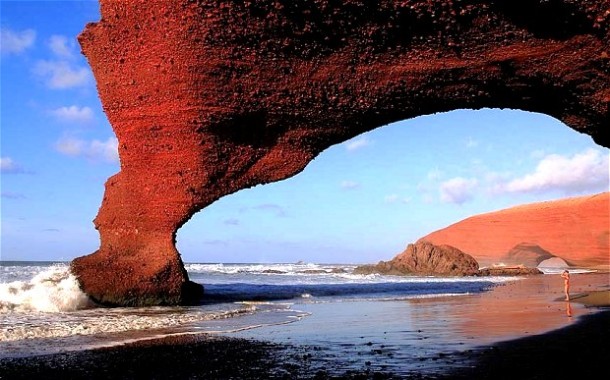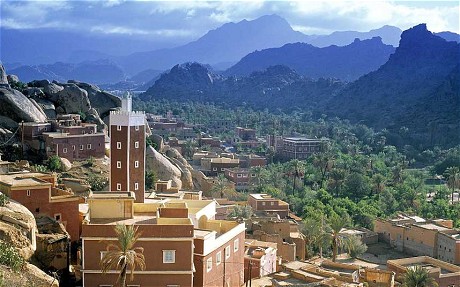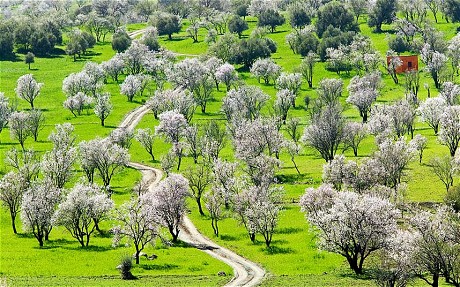AGADIR: COASTING DOWN BIG SUR IN MOROCCO ‘HEART-STOPPINGLY BEAUTIFUL’- LONDON TELEGRAPH

The red cliffs of El Gezira
*”On the road from Agadir, Tara Stevens encounters dramatic beaches, lunar-like landscapes & the majestic Atlas Mountains. Mother Nature seems to have been working overtime…’heart-stoppingly beautiful’.”*
London Telegraph, by Tara Stevens (April 28, 2013) — The light, when we step off the flight from snowy London, is heavenly: a deep, cerulean blue where a cloudless North African sky meets the limitless horizon of the Atlantic. But the man-with-the-sign who’s meant to take us to our car is nowhere to be seen. I ring the help line. “Hello, Mrs Stevens,” says the voice at the end of the telephone, “We’re here in Marrakesh waiting for you.”
This being Morocco it is a “no problem, madam”, moment, and soon Saaïd, the one-man operation of the Agadir branch of Holiday Inn Cars, has appeared with our vehicle. He bids us a pleasant trip, tells us to call if we need anything at all and we’re on our way, heading south on highway N1. Our plan is to loop south along the coast road to Sidi Ifni, a former Spanish outpost overlooking the Atlantic, and then double back to Agadir via the lunar-like landscapes of the Anti-Atlas.
The first part of the journey is a dull, 30-mile stretch of dusty, satellite towns. But as we near Tiznit they give way to shady avenues of plane trees, pink earth and hand-painted signs written in the Tifinagh alphabet of the Amazigh people of this region, which point us towards the terracotta red crenellations of the town.
As Moroccan towns go this is a very laid-back affair, named after a reformed prostitute, Lalla Tiznit, whose repentance was rewarded by God with a freshwater spring, the Source Bleu. These days stagnant and green would be a more accurate description, but the Tiznit that grew up around it became a thriving centre for beaten metal wares, silver jewellery and enamelled cutlery and the Thursday and Friday open-air souk is considered one of the best in Morocco.
We stayed for lunch – a chicken and golden onion tagine – then headed west, cross-country, along valleys as green as any shire, over plump rolling hills and past sprays of forest until suddenly, from high on a ridge, the Atlantic appeared before us, like a frothy blue carpet.

This extraordinary stretch of road runs south parallel to the ocean from the isolated cove of Gourizim all the way to Sidi Ifni (nearly 40 miles away) and save for the odd grand taxi – the battered old Mercedes that here are painted green and yellow to resemble California surf mobiles from the Sixties – there is virtually nothing and no one on it.
Arranged along the cliff tops like a great blue-and-white wedding cake, Sidi Ifni was occupied by the Spanish from 1476 to 1524, and again from 1860. In 1912 it fell to the French protectorate, and was finally given back to Morocco in 1969, but what you see today still has a very colonial feel. With little by way of sights – unless you count the retired Europeans who descend in their motor homes for the winter – this is a place in which to do nothing more than mooch about admiring the Art Deco architecture of the largely disused Spanish consulate, the palace, the lighthouse and the old Hotel Bellevue.
We started and ended our days on the elegant promenade above the beach where we’d have coffee and chocolate croissants in the mornings, and later stroll about under the stars nibbling freshly popped corn from old-fashioned tin drums. In between we’d take long walks on the beach and lazy lunches of grilled fish marinated in turmeric, lemon juice and parsley eaten beneath the colourful parasols of the arcaded market. It’s easy to see how days could drift into weeks, months, even years here.
If the beach at Sidi Ifni is impressive it is nothing compared to those of Mirleft and particularly Legzira, farther north up the coast. Although a Spanish-style development is slowly taking shape on the cliffs above Legzira, down on the beach the original hamlet remains as it always was: a cluster of simple guesthouses and beach bars framed by fire-red cliffs that seem to burst into flame at sunset.
This is the hour to visit, and a couple of beaches along you’ll find a series of magnificent arches, carved by waves rolling over from America. Like great, gaping jaws they leave you feeling quite humbled by the sheer power of it all.
Indeed, Mother Nature seems to have been working overtime in these parts. We drove from Sidi Ifni to Gourizim, then continued north on the coast road to Aglou where the landscape turns to lush, green rolling hills sprinkled with palm trees. Then back through Tiznit and east towards Tafraoute, up, up and away into the Anti-Atlas. The heart-stoppingly beautiful drive reaches heights of over 8,000ft and is punctuated by rammed-earth villages clinging to the sides of ravines and the odd kasbah perched on a stony outcrop.
Tafraoute is comparatively low at about 4,000ft, but it occupies a dazzling spot in the heart of the Ameln Valley. It’s a sweet little town and an excellent base for exploring this wilderness by foot, mountain bike or paraglider.
Known for boulder fields that look as though a giant has been playing marbles across the high desert floor, the chief attractions here are the prehistoric rock paintings at Ukas, contrasted somewhat incongruously by Les Roches Bleues, the 1984 work by the Belgian artist Jean Vérame who took it upon himself to paint several acres of these monumental pebbles in cerulean blue, hot pink and emerald green on the nearby plains of Agard Oudad. The effect is striking and bizarre, and you can easily lose several hours here half expecting that one of them might actually hatch.
The final push west over a great wall of mountain to get back to Agadir is tremendous, the scenery flattening into a Martian-like landscape on the top and springing back into life as you dive back into valleys lush with almond trees, their blossom gusting in the breeze like snowflakes.

This is the road to Aït Baha, where much of the region’s best Argan oil comes from. Revered for its cosmetic and culinary qualities, the oil was traditionally obtained by milling the half-digested pits of the Argan nut gathered from the waste of grazing goats.
These days they are harvested by hand, but we saw several trees filled with little black goats with Mohican manes and came face-to-face with great herds of dromedary camels, their sinewy necks reaching into the upper branches for Argan nuts too. Imagine, just 30 minutes from Agadir, but it felt like a million miles from anywhere.
It was a shock to get back to the traffic-choked city, but even that had its compensations. With the same laid-back character that distinguishes the Moroccan south it has wide, palm-lined avenues, a pretty kasbah located 750ft above the sea, and endless, perfectly kept beaches.
Following a catastrophic earthquake in 1960, which completely destroyed the medina, the city commissioned the Medina de Coco Polizzi – an Italo-Moroccan oddity that’s sure to please lovers of kitsch. Covering four hectares, it showcases various Moroccan architectural styles from the ornate zellige and plaster-covered palaces of Fez to the rammed-earth kasbahs of the Atlas, interspersed with shops hawking fixed-price artisan wares, and cafés and restaurants serving traditional food.
For our last night however, we headed to Agadir’s swanky new marina. Settling into a hip, seafood restaurant with a two-tier platter of grilled lobster before us and a bottle of ice-cold, salmon-hued Moroccan wine, we raised a glass: to spring on Morocco’s Big Sur.
morocco culture,moroccan food,morocco food,moroccan cuisine,morocco beaches,moroccan meal,beaches in morocco,moroccan culture,hercules cave,hercules cave morocco